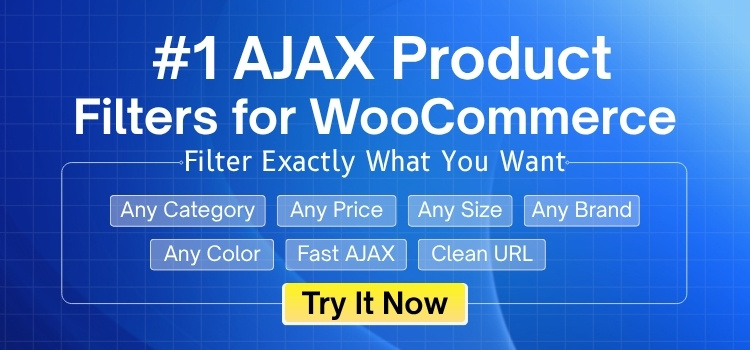Category filters often act like shortcuts that make online shopping simpler. They cut through the clutter of large product lists and guide buyers straight to what they need. Many store owners and shoppers alike wonder, can WooCommerce category filter improve store navigation?
Yes, a WooCommerce category filter can improve store navigation by reducing search time, organizing products, and guiding shoppers easily. It creates a smoother experience, builds trust, and helps customers find what they need faster, especially on mobile.
If you are curious to know how these filters work in detail, this article covers everything clearly. From saving time and improving user experience to boosting SEO, here you will find every important point explained in simple and easy words.
Can WooCommerce Category Filter Improve Store Navigation?
People shopping online often want to find products quickly without going through endless pages. A big store with many items can sometimes confuse buyers and make them leave before buying anything. Let’s see how category filters can make things simple.
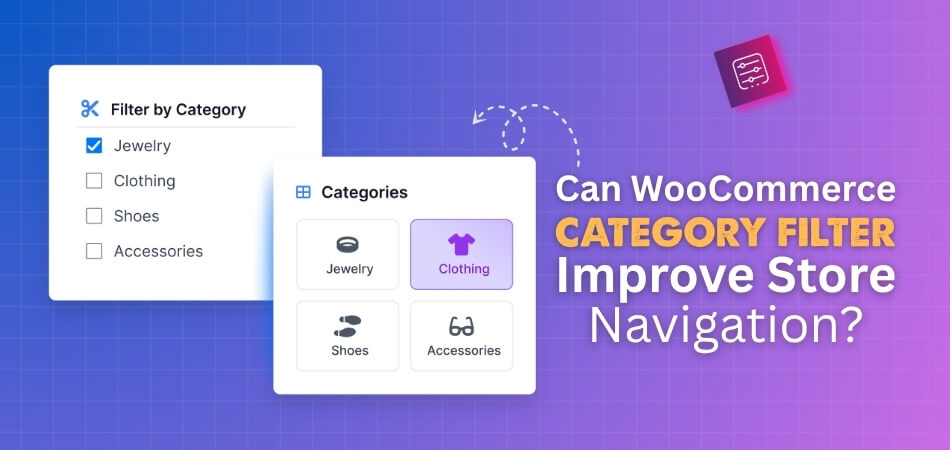
Reduces Search Time
Customers want fast results when they look for something online. Instead of scrolling through dozens of items, they can simply choose the category that matches their need. With this small step, they save time and energy, making shopping quicker and easier.
Enhances User Experience
Shopping feels smoother when the process is simple. A clear category filter shows customers exactly where to go and how to find what they want. The easier the steps, the more pleasant the experience, which encourages them to shop more confidently.
Combats Frustration
Too many products without any clear sorting can overwhelm buyers. When there are simple filters in place, the clutter disappears. This helps shoppers stay calm, focused, and interested in checking more products instead of feeling lost.
Boosts Engagement
People spend more time in a store when it feels easy to browse. Filters allow them to move from one option to another without hassle. This increases curiosity, and they may end up exploring items they didn’t plan to check at first.
Increases Conversions
When shoppers can find what they want quickly, they’re more likely to buy it. A smooth and short shopping path often ends with a purchase. This simple tool can increase conversions and reduce abandoned carts in an online store.
Organizes Large Stores
Stores with a wide range of products often feel messy without proper structure. Category filters bring clear organization, guiding people step by step. Sometimes using a WooCommerce product category filter plugin adds an extra layer of order, making large catalogs easier to explore.
Saves Customer Effort
Finding the right product should not feel like hard work. Filters cut down the effort by leading customers directly to their choices. This helps reduce confusion and keeps them happy while browsing. Less effort means a better shopping mood.
Builds Customer Trust
Everything that looks organized and clear makes customers feel they are in a professional store. A simple system of categories shows that the store cares about the buyer’s time. Trust grows as people see that shopping is easy and well thought out.
Improves Mobile Shopping
On mobile devices, scrolling through hundreds of products can be tiring. Filters are especially helpful here, as they make the browsing process smooth. Customers can find products with just a few taps, which makes the mobile shopping experience far more comfortable.
With simple tools like category filters, an online store can feel less like a maze and more like a guided path. This small detail saves time, keeps buyers happy, and increases the chances of more sales.
How Do Themes and Plugins Influence Category Filter Navigation?
Online shopping is faster with filters that guide customers to the right products. Their look and function often depend on the site’s theme and plugins. Design choices and plugin support together decide how smooth and user-friendly the filtering system becomes. Let’s explore how these factors shape the shopping experience.
Visual Style
Themes control the overall look of a website, and this extends to how category filters appear. A clean theme can make filters simple and easy to use, while a cluttered theme may make them confusing. Colors, fonts, and layout all play a role.
User Experience
Plugins can improve how filters work behind the scenes. For example, some plugins let filters update results instantly without reloading the page. This makes shopping smoother because users don’t need to wait or click multiple times.
Custom Options
Themes often come with built-in settings that let store owners change filter layouts. Some allow dropdowns, checkboxes, or sliding ranges. For stores built with page builders, owners often add filter with Elementor to keep category navigation consistent with the overall design.
Mobile Use
A good theme makes sure filters are easy to use on smaller screens. If filters are hidden in tiny buttons or placed awkwardly, people may skip using them. Plugins also help by giving responsive features like collapsible sections or mobile-friendly menus.
Compatibility
Not all themes and plugins work well together. When they clash, filters may not show correctly or could stop working. That is why testing both design and plugin setups is important before running a store for customers.
Themes decide how filters look, and plugins decide how well they function. Both need to work together to give shoppers a smooth and simple navigation experience.
What Common Mistakes Reduce the Effectiveness of Category Filters?
People using category filters on websites expect them to make finding products or content easier. At times, these filters fail because of common mistakes. Poor design can confuse visitors and even push them away. Let’s look at the issues that reduce filter effectiveness.
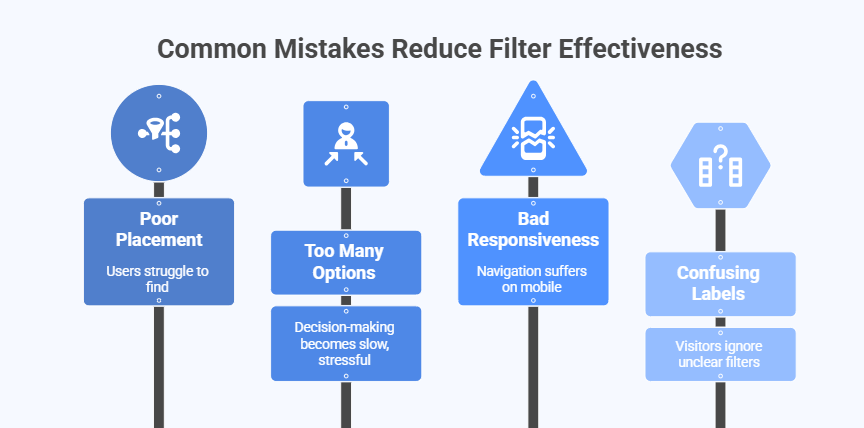
Poor Placement
If filters are placed in hidden or unusual spots, users often struggle. They expect to see them on the left side or at the top. When filters are not easy to locate, people may leave quickly. This mistake reduces usability and harms the shopping or browsing experience.
Too Many Options
Having endless filter choices makes decision-making slow and stressful. Visitors often feel overwhelmed when they face long lists of confusing filter options. Instead of helping, this situation can waste a lot of time. People prefer filters that are clear, short, and easy to understand.
Bad Responsiveness
When filters don’t work well on phones or tablets, navigation suffers. Many users shop or browse on mobile devices, so filters must adapt. A poorly responsive design can frustrate visitors and drive them away. Every device should display filters clearly and make them work smoothly.
Confusing Labels
Filters with unclear or technical labels confuse people and waste time. If a visitor cannot understand a filter, they may ignore it. This problem often leads to incomplete searches and missed items. Clear and simple wording helps everyone use filters without any confusion.
Category filters should guide visitors instead of frustrating them. Good design makes filters easy to find and simple to use. Avoiding common mistakes can keep users engaged and satisfied. Simple, effective filters create better experiences and encourage people to stay longer.
How Do Store Owners Measure the Impact of Category Filters on Navigation?
Online stores add category filters to understand their impact. These tools help shoppers cut search time and find products faster. Store owners track performance closely to see whether filters increase sales. Let’s explore the ways they measure the success of these filters.
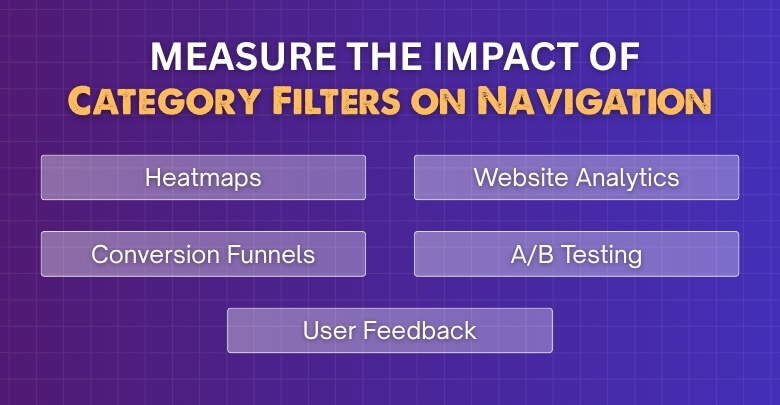
Heatmaps
By studying heatmaps, store owners can understand where shoppers click most. These colorful maps highlight activity zones and show which filters attract attention. If certain filters hardly get clicks, adjustments may be needed soon. Heatmaps give a simple visual way to check filter usefulness.
Website Analytics
Through website analytics, owners gain details about visitor actions and patterns. They can track how many users click filters and what follows. If using filters leads to longer visits or purchases, it matters. Analytics provide real data to judge the performance of filters.
Conversion Funnels
Looking at conversion funnels helps owners follow the shopping path clearly. Each stage, from browsing to checkout, shows where users succeed or stop. If filter users move faster to checkout, that’s a positive sign. Funnels give step-by-step evidence of how filters affect buying behavior.
A/B Testing
Running A/B tests gives store owners direct comparisons between filter setups. Two groups see different layouts, and their results are tracked closely. The winning version is the one that improves shopping speed and sales. This method ensures changes are based on clear shopper behavior.
User Feedback
Hearing from real shoppers gives insights that numbers cannot always explain fully. Simple surveys or feedback forms can reveal frustrations with filter designs. Honest answers guide owners on what should stay or be improved. Feedback adds a personal view to the overall performance check.
Category filters can greatly influence how customers explore products and shop. Store owners depend on tools and feedback to measure these effects. Tracking numbers alone is not enough, so combining methods gives better clarity. A mix of data and feedback makes online shopping stronger.
Can Custom Category Filters Improve SEO in WooCommerce Stores?
When people shop online, they want to find what they need quickly. For a WooCommerce store, filters can make the browsing process much smoother. But how these filters are built can also affect how search engines view your store. Let’s look deeper into this.
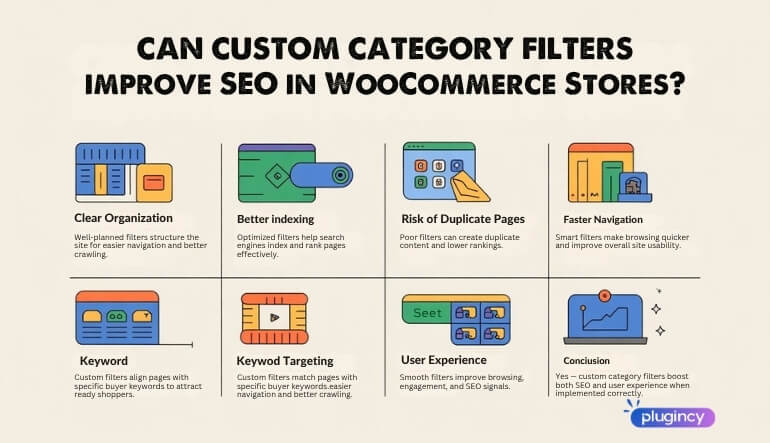
Clear Organization
Well-planned product filters give a clear structure to a website. This helps both shoppers and search engines understand how items are grouped. Some store owners choose to create custom category filters to organize content more clearly, which can also help search engines crawl product pages efficiently.
Better Indexing
Filters that are properly set allow search engines to index pages in a neat way. Each filtered view can become an extra page that search engines may rank. If these are targeted with relevant keywords, it increases the chances of showing up in searches.
Risk of Duplicate Pages
Poorly built filters often create multiple pages with the same or very similar content. This can confuse search engines and lead to duplicate content issues. As a result, the store may lose ranking power instead of gaining it.
Keyword Targeting
Custom filters give a chance to match pages with specific keywords that buyers search for. For example, a filter for “red running shoes” can match that exact phrase. This focused setup helps bring in shoppers who are ready to buy.
User Experience
Search engines pay attention to how users interact with a site. Easy filters improve browsing, keep visitors on the site longer, and reduce bounce rates. A smooth shopping experience sends positive signals that can improve rankings over time.
Custom category filters can either strengthen or weaken SEO in WooCommerce stores. When done with care, they make products easier to find for both shoppers and search engines. But a careless setup can hold back the store’s growth.
FAQs About Can WooCommerce Category Filter Improve Store Navigation?
Category filters are more than just sorting tools. They play a big role in how people move through an online store and how easy it feels to shop. Below are some of the most common questions and answers that can help you understand this better.
How Do Category Filters Support Product Discovery in WooCommerce?
Category filters act like signboards that guide shoppers directly to what they want. Instead of browsing through all items, customers can choose the category that fits their needs. This makes discovery faster and simpler. The easier it is to find products, the more enjoyable the shopping feels.
Why Are Category Filters Important for Store Navigation?
Without clear filters, shoppers may get lost in a sea of products. Filters break things down into neat sections that are easy to move through. They reduce the time spent searching and make the shopping path more direct. This helps customers feel more in control while browsing.
Can Category Filters Be Personalized for Shoppers?
Yes, filters can be set up to show popular categories first or highlight trending items. Personal touches like this make navigation more relevant to each shopper. When filters show what matters most, people are likely to spend more time exploring. A tailored filter setup keeps browsing fresh and useful.
Do Category Filters Affect Shopping Cart Abandonment?
Confusing filters can slow down the shopping process and frustrate buyers, which often leads to abandoned carts. Simple and clear filters guide users faster toward checkout. A smooth experience reduces distractions and keeps people focused on buying. This directly lowers the chances of incomplete purchases.
How Do Category Filters Work With Store Speed?
If filters are slow or cause reloads, the whole shopping process feels heavy. Good WooCommerce filters are built to update results quickly. This makes product browsing smooth and keeps users from leaving the site. Speed is key to keeping shoppers engaged.
Can Filters Be Used to Highlight Promotions or Discounts?
Yes, store owners can add special filters like “On Sale” or “Discounted Items.” This lets buyers quickly find deals without scanning every page. Highlighting promotions through filters encourages faster decisions. It also makes shoppers feel they are saving both time and money.
How Do Category Filters Impact New Visitors?
For first-time visitors, clear filters act as a guide to understand the store’s structure. Instead of guessing where to look, they can click categories to explore products easily. This reduces confusion and builds a positive first impression. A good filter setup can turn new visitors into regular shoppers.
Are Category Filters Helpful for Seasonal Products?
Yes, filters can be updated to highlight seasonal categories like “Winter Collection” or “Back to School.” This makes it easy for shoppers to find timely items. Seasonal filters keep the store fresh and relevant. They also draw more attention to limited-time products.
Can Filters Improve Accessibility for All Shoppers?
Well-designed filters make it easier for everyone to shop, including people who may struggle with long scrolling. Clear labels and simple layouts improve usability. Accessibility-friendly filters make sure no shopper is left behind. This widens the customer base and builds a stronger store reputation.
How Do Filters Influence Customer Loyalty?
When shoppers know they can find products easily, they are more likely to come back. A reliable filter system creates trust and satisfaction. Over time, this builds loyalty because customers prefer a store where shopping feels easy. Filters play a quiet but powerful role in repeat visits.
Conclusion
Good category filters always make online shopping or browsing simpler and useful. When designed well, they guide visitors quickly to what they want and save them time. This shows a clear answer to the question, Can WooCommerce category filter improve store navigation? Yes, it really can.
Simple changes can help filters work much better and keep users happy. Always use clear labels, make placement easy, and ensure a mobile-friendly design. Keep things short, test filters often, and avoid overload. Follow these tips, and I wish you all the best.
